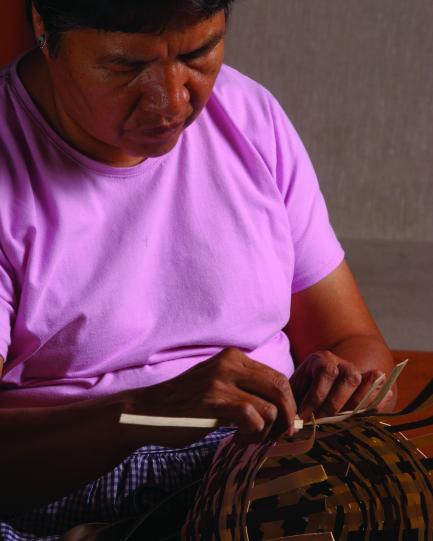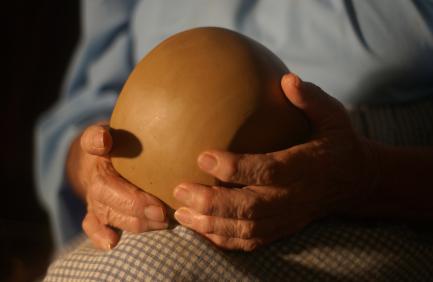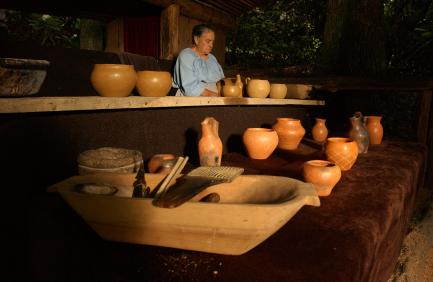Citizens of the Cherokee Nation dressed in traditional clothing. From left, Noel Grayson, Daimian Beaver, Olivia Beaver, Colleen Jumper Daugherty and Gabrial Beaver. (Photo courtesy of the Cherokee Nation /National Museum of the American Indian)
National Museum of the American Indian Celebrates Cherokee Days
The Smithsonian’s National Museum of the American Indian in Washington, D.C., presents Cherokee Days, a free three-day festival featuring storytelling, films, dance, music, family activities and demonstrations from citizens of the Cherokee Nation and the Eastern Band of Cherokee Indians, April 3–5 from 10 a.m. to 5:30 p.m. See the full schedule here.
For the first time in intertribal history, the Cherokee Nation and Eastern Band of Cherokee Indians are partnering on this program that shares the true Cherokee story. Visitors will see traditional dancing performances several times a day in the Potomac Atrium along with the Cherokee National Youth Choir that has performed at the Macy’s Thanksgiving Parade and for presidents. Tommy Wildcat, who is a Cherokee National Treasure, will perform traditional flute music, and Junior Miss Cherokee, LaNice Belcher, will perform a piano concert in the museum’s Rasmuson Theater. Booths in the Potomac Atrium will allow visitors to meet and talk to artists who specialize in basketry, pottery, carving and textiles.
Visitors can learn more about the Cherokee language with Roy Boney, listen to traditional stories by Robert Lewis, gain appreciation for Cherokee art with artists Shan Goshorn and America Meredith, attend a lecture about the historic Trail of Tears with Catherine Foreman Gray or delve into Cherokee genealogy with Roy Hamilton. Hands-on activities for kids and families will include making cornhusk dolls, molding their own clay medallion or making mini stickball sticks. Visitors can also see an exhibition that showcases a timeline of historical milestones.
Two films will be screened daily: Indian Country Diaries: Spiral of Fire, in which author LeAnne Howe (Choctaw) journeys to the North Carolina homeland of the Eastern Band of Cherokee Indians and discovers how their fusion of tourism, cultural preservation and spirituality is working to ensure their tribe’s vitality in the 21st century, and Trail of Tears: A Cherokee Legacy, which explores one of America’s darkest periods: President Andrew Jackson’s Indian Removal Act of 1830 and the forced removal of the Cherokee Nation to Oklahoma in 1838. Nearly a quarter of the Cherokee National died during the Trail of Tears, arriving in Indian Territory with few elders and even fewer children. Cherokee actor Wes Studi is the on-camera presenter, and it is narrated by James Earl Jones.
“We are honored to host this historic joint endeavor of the Cherokee here at the museum,” said Kevin Gover (Pawnee), director of the museum. “Their contributions to the national story and history are legendary, but their legacy continues with events like this to teach others about their contemporary tribal successes and how they maintain their culture in the face of a changing cultural landscape.”
Cherokees originally inhabited the lands in what are now present-day Tennessee, North Carolina, Alabama and Georgia. Following the 1838 forced removal of 16,000 Cherokees to present-day Oklahoma, many defied the relocation and remained in North Carolina. March 24, 1839, is documented as the day the last detachment of Cherokees traveling the Trail of Tears arrived in Indian Territory. This year marks the 175th anniversary of this event.
Today there are three federally recognized branches of Cherokee people: Cherokee Nation, located in Tahlequah, Okla., Eastern Band of Cherokee Indians, located in Cherokee, N.C., and the United Keetoowah Band of Cherokee Indians, located in Tahlequah, Okla. Each tribe, while wholly unique, shares a past, language, culture and traditions.
In 1984, the tribes met in Red Clay, Tenn., for the first time since the tribe was divided. During the past 30 years, the Cherokee Nation and Eastern Band have worked together on numerous projects, including maintaining a unified language.
The discussions on Friday and the performances on Saturday will be webcast live here.
For additional information, visit www.AmericanIndian.si.edu.
# # #
SI-121-2014





